 | 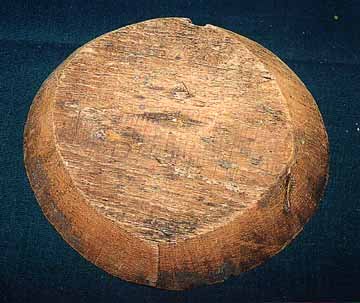 |
Outhouse Hole Cutout (top view)
Recovered from an Outhouse Digging
Photo by J. Loose
Donated by Charles Cook | Outhouse Hole Cutout (Bottom View) Recovered from an Outhouse Digging
Photo by J. Loose
Donated by Charles Cook |
 |
Outhouse Hole Cutout (side view)
Recovered from an Outhouse Digging
Photo by J. Loose
Donated by Charles Cook |
 |
 |
Old New Orleans Creole Mustard Bottle
Recovered During an Outhouse Digging
Photo by J. Loose
Donated by Charles Cook | Close-up of New Orleans Creole Mustard Bottle
Recovered from an Outhouse Digging
Photo by J. Loose
Donated by Charles Cook |
 |  |
Aqua Vial which held Medicine or Possibly Opium
Recovered from an Outhouse Digging
Photo by J. Loose
Donated by Charles Cook | Another View of the Aqua Vial which held
Medicine or Possibly Opium
Recovered from an Outhouse Digging
Photo by J. Loose
Donated by Charles Cook |
Here is Charles's expert, detailed explanation of what is shown above. I think you will all agree, he knows what he is talking about!
The hole...technically the hole was in the bench after it was cut out.
However, we have always called them holes, in the same sense that there
are so called doughnut holes sold from what's cut out of the doughnuts.
The hole shown above dates to the 1870's. Since it was deep enough to have been cut off
from oxygen, it is very well preserved. The side with the largest
diameter is the top. Picture a saw in your hand. Wouldn't that angle be
the most comfortable. There was no electric jig saws in those days. Like
yours, many of them had a nail or something nailed into the center. Note
the dot of rust in the center. What this was for is a mystery. If it was
to hold the cut out, why were so many found at the bottom of the hole?? [This comment from a visitor is probably the correct reason why; "The reason for the nail in the holes was to draw the circle for the man to cut out the hole; a string was tied to the nail and a pencil or another nail to draw the circle."]
The bottles...they have lot to say.
The mustard jar. Of course it has that date on it (On the back is printed "Registered Feb. 23-1892 No 20744."). However, even
without that there are other characteristics that tell us a lot. Note
that each side shows a line running from the bottom and stopping somewhere
on the neck (You can see the line on the left photo). These were caused by the seam in the mold the bottle was
blown in. A bottle is a glass bubble. This one was hand blown into a
mold with a single hinge, with the embossing on the inside, reversed, in
order for it to come out right on the bottle. This type is commonly
called a two piece mold. There were three and even four piece molds which
resulted in that many seam marks. The bottle is of clear glass. The
natural color of glass is various shades of aqua. To bleach the glass,
manganese was added. Other things could be added for other colors...gold
for ruby...cobalt for blue, and so on. Incidentally, when glass with
manganese is exposed to ultraviolet light from the sun for long periods of
time it turns some shade of purple. During World War I, our supply of
manganese was cut off by the Germans. Then glass makers turned to
selenium to bleach...no more purple, sun colored glass. Selenium glass
did turn slightly yellow. To continue with this "run on paragraph"...Note
the swirls in the glass (the swirls can be seen in both photo's). Glass is a mixture of melted silicon (sand),
lime, and potash. Sometimes the "batch" was not so well mixed. After
over a century of exposure to dampness, the parts that were not well
mixed, and therefore softer, began to leach away. That's what you are
seeing. In wet ground like that of New Orleans, this process happens as
fast in 200 years as it did in 2000 years in Egypt. Finally, note that
there are bubbles in the glass (not readily seen in the photo's). In 1903 a man named Owens invented a
bottle blowing machine. When hand blowing bottles, the blower dipped
glass from the top of the vat. The machine got it from the bottom...no
more bubbles. By about 1910 the machine had run all but specialty blowers
out of business. On machine made bottles the seam runs clear over the top
of the lip. The machine finishes on the bottom. All this has also told
some ways a bottle can be dated.
The aqua vial...It wasn't bleached. Dates about 1870...two piece
mold...flared lip...not tooled or added on. Blower just cut it off the
blow pipe, and while still soft, and flared the neck out. It probably held
medicine, possibly even opium, which was legal into the 20th
century...laudanum.
These aren't extremely valuable. They are proof that history is found in
the outhouse. Charlie
|
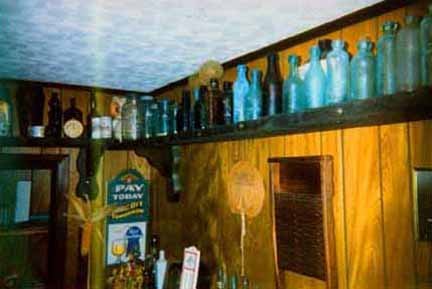 |
Samples of bottles dug out of Outhouses
Photo by Charles Cook |
| This photo shows some of the bottles Charles has dug out of Outhouses. On the right are mostly soda and beer bottles. To the far left are pickle bottles and in the corner are canning jars.
|
 |
Civil War Era bottles dug out of Outhouses
Photo by Charles Cook |
| On the lower left are various types of medicine bottles. Note that the five gallon demijon was not dug out of an Outhouse.
The upper shelf items are all pre-Civil war except red pitcher (red spunge ware). Pitchers and bowls generally were called mocha ware. Patterns include seaweed, oak tree, worm ware and banded. The large mouth food bottle is circa 1820's Civil War age demijon.
|
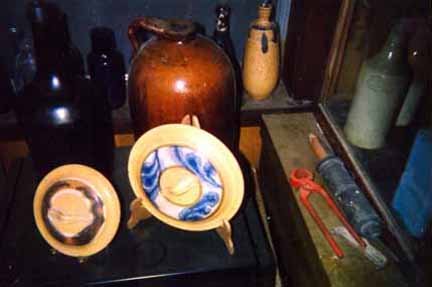 |
Mocha chamber pot lids both sea weed pattern circa 1840's
Photo by Charles Cook |
| This photo shows Mocha chamber pot lids, both with sea weed pattern, circa 1840's. The jug and demijon are about 2 gallon size. In the case at the right are stoneware beer bottles. Notice the blob seal with the New Orleans company name, circa 1860.
|
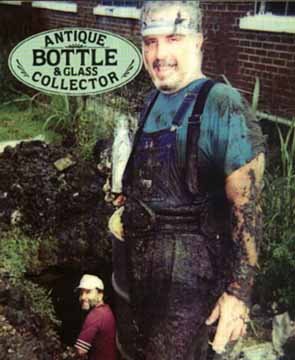 |
What it looks like when you are Outhouse Digging!
Photo by Charles Cook |
| This photo was recently on the cover of a magazine. It shows Charles old digging partners, Terry Guidroz and his cousin John Gautreaux. It depicts the digging of a pretty big hole. That's a little cathedral pickle bottle he's holding...the panels look like church windows.
|
And now; The most important thing to know about how to make an Outhouse Digging Probe:
We can't tell you where to get the material for a probe in your area...inquiries to local machine shops and/or welding shops might give some answers. You need spring steel stock, no more than about 3/8's in diameter and 5 to 6 feet long, depending on your height and ability to manage. If you are 5-11, 6 feet is a little awkward so you may have to adjust accordingly. To one end weld a piece of 3/4" pipe for a Tee handle. To the other end, weld a tip of some hard metal, just slightly larger than the diameter of the shaft. This makes a slightly larger hole than the shaft and allows for easier penetration and removal. In Louisiana, the tip was made of stilite (not sure of the spelling). This is an alloy used in the trim of high pressure industrial motor valves to prevent them from cutting out, particularly when fluids are passing through them.
Local plumbers and utility workers use similar probes to locate underground pipes. They usually get them from plumbing suppliers. Often, these are too large in diameter, making them difficult to use. The spring steel makes for more strength in a smaller diameter, without bending.
|
Additional Information! Hello,
I’ve been constantly amazed, over the years by the amount of response my little corner of John Loose’s web site generates, from all over the world. I am his resident bottle digger. He passed your query on to me.
While I hate to discourage anyone, I must tell you I wouldn’t dig anything as “young” as you seem to be into. In the first place, I don’t think enough time has gone by for decomposition to have taken care of the “yuk factor”. In the second, it would seem to be young enough that little of anything of value would be found. Bottles were blown by hand before the automatic bottle machine was invented in 1903. By 1910 virtually everything but specialty items were machine made. The seam on a hand blown bottle does not go all the way up the neck to the lip. Machine made bottles are started on the lip and finish on the bottom. On the other hand, when I first started the late hand blowns were only sixty some odd years old. Later bottles are now becoming more collectable. Never the less, privies at least one hundred years old are usually the only ones worth digging at this time.
Concrete is seldom a good sign. Older privies usually had sides of wood, brick, or stone.
Since I get these requests so often, I’ve put a little paper together about finding and digging privies. More often than not, there is little or no evidence visible to indicate a privy site. That is why probes are used. The “sink” you mention may well be the site of an earlier pit. It helps to know the history of the property you are digging.
Feel free to ask more if you need to. I’m always interested in hearing about people’s successes or even failures.
Good hunting,
Charlie Cook in Louisiana Bayou Country
|
| What else can you see in the images shown? Many times a photo is worth a thousand
words and I've only elaborated with a few so here is
your chance to add
some "color commentary" to my collection. If your addition is worthy, you
will find the quote added on the Comments to the Curator
page. You can use Email to respond. |
Have you
seen all the Outhouses yet?
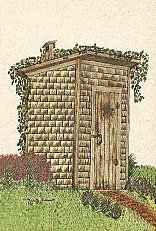 Return to the Outhouse Tour by clicking HERE!
Return to the Outhouse Tour by clicking HERE!
Stamp here to "dump" mail to the official Outhouse
Curator...

Return to my home page...
Copyright © 1999-2006
This Home Page was created on May 29, 1999
Most recent revision September 13, 2006
|